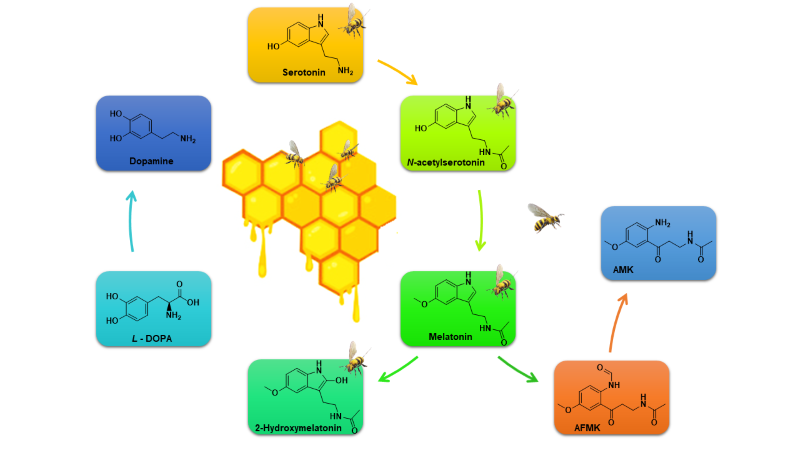Serotonin, melatonin and their precursors and metabolites and vitamin D3 derivatives in honey
Biogenic amines, melatonin and secosteroids in honey
Abstract
We are commenting recent discoveries on the presence of L-DOPA, dopamine, 5-hydroxytryptophan, tryptamine, serotonin, N-acetylserotonin, melatonin, 2-hydroxymelatonin, AFMK and AMK in honey. Serotonin and melatonin, products of the tryptophan metabolism, are widely produced in nature, serving as hormones, neurotransmitters, biological regulators, neurotransmitters and antioxidants, in a context dependent fashion. Dopamine and tryptamine are important neurotransmitters across different species. Honey is used as one of the most popular healthy food substances. Detection of above molecules in honey accompanied by detection of vitamin D3 and its hydroxyderivatives, is consistent with their detection in insects and plants. Their presence in honey enhances spectrum of its beneficial effects for human health and implicates that these molecules must play important role in social insects physiology, bees development and colony functions.
References
2. Crane E (2020) Honey, a comprehensive survey. In Crane E Ed. International Bee Research Association & Northern Bee Books.
3. Saikaly SK, Khachemoune A (2017) Honey and wound healing: An update. Am. J. Clin. Dermato.l 18: 237-251.
4. Anonymous (2012) Honey between traditional uses and recent medicine. Macedonian J. Med.Sci.10.3889/mjms.1957-5773.2012.0213.
5. El-sound NHA (2012) Honey between traditional uses and recent medicine. Macedonian J. Med. Sci. 5: 205-214.
6. Ahmed S, Othman NH (2013) Honey as a potential natural anticancer agent: A review of its mechanisms. Evid. Based Complement Alternat. Med. 2013: 829070.
7. Khalil I, et al. (2012) Physicochemical and antioxidant properties of Algerian honey. Molecules 17: 11199-11215.
8. Almasaudi S (2021) The antibacterial activities of honey. Saudi. J. Biol. Sci. 28: 2188-2196.
9. Mandal MD, Mandal S (2011) Honey: Its medicinal property and antibacterial activity. Asian Pac. J. Trop. Biomed. 1: 154-160.
10. Oduwole O, Udoh EE, Oyo-Ita A, Meremikwu MM (2018) Honey for acute cough in children. Cochrane Database Syst. Rev. 4: CD007094.
11. Waheed M, et al. (2019) Honey and cancer: A mechanistic review. Clin. Nutr. 38: 2499-2503.
12. Kim TK et al. (2021) Detection of serotonin, melatonin, and their metabolites in honey. ACS Food Sci. Techno.l 1: 1228-1235.
13. Kim TK, et al. (2020) Detection of 7-dehydrocholesterol and vitamin D3 derivatives in honey. Molecules 25 (11): 2583.
14. Borges CV, et al. (2022) Tryptophan and biogenic amines in the differentiation and quality of honey. Int. J. Tryptophan Res. 15: 11786469221102098.
15. Al ML, et al. (2009) Physico-chemical and bioactive properties of different floral origin honeys from Romania. Food Chem. 112: 863-867.
16. Drivelos SA,. Danezis GP, Halagarda M, Popek S, Georgiou CA (2021) Geographical origin and botanical type honey authentication through elemental metabolomics via chemometrics. Food Chem. 338: 127936.
17. Quideau S, Deffieux D, Douat-Casassus C, Pouysegu L (2011) Plant polyphenols: Chemical properties, biological activities, and synthesis. Angew. Chem. Int. Ed. Engl. 50: 586-621.
18. Scalbert A, Manach C, Morand C, Remesy C, Jimenez L (2005) Dietary polyphenols and the prevention of diseases. Crit. Rev. Food Sci. Nut.r 45: 287-306.
19. Olszewska MA, Gedas A, Simoes M (2020) Antimicrobial polyphenol-rich extracts: Applications and limitations in the food industry. Food Res. Int. 134: 109214.
20. Prakash MD, et al. (2021) Anti-cancer effects of polyphenol-rich sugarcane extract. PLoS One 16: e0247492.
21. Back K, Tan DX, Reiter RJ (2016) Melatonin biosynthesis in plants: multiple pathways catalyze tryptophan to melatonin in the cytoplasm or chloroplasts. J. Pineal Res. 61: 426-437.
22. Hardeland R, et al. (1995) On the primary functions of melatonin in evolution: mediation of photoperiodic signals in a unicell, photooxidation, and scavenging of free radicals. J. Pineal Res. 18: 104-111.
23. Tan DX, et al. (2014) Fundamental issues related to the origin of melatonin and melatonin isomers during evolution: Relation to their biological functions. Int. J. Mol. Sci. 15: 15858-15890.
24. Zhao D, Wang H, Chen S, Yu D, Reiter RJ (2021) Phytomelatonin: An emerging regulator of plant biotic stress resistance. Trends Plant Sci. 26: 70-82.
25. Slominski A, Paus R, Are L-tyrosine and L-dopa hormone-like bioregulators? J. Theor. Biol. 143: 123-138.
26. Slominski A, Zmijewski MA, Pawelek J (2012) L-tyrosine and L-dihydroxyphenylalanine as hormone-like regulators of melanocyte functions. Pigment Cell Melanoma Res. 25: 14-27.
27. Umek N, Geršak B, Vintar N, Šoštarič M, Mavri J (2018) Dopamine autoxidation is controlled by acidic pH. Front. Mol. Neurosci. 11: 11:467.


This work is licensed under a Creative Commons Attribution 4.0 International License.
For all articles published in Melatonin Res., copyright is retained by the authors. Articles are licensed under an open access Creative Commons CC BY 4.0 license, meaning that anyone may download and read the paper for free. In addition, the article may be reused and quoted provided that the original published version is cited. These conditions allow for maximum use and exposure of the work, while ensuring that the authors receive proper credit.
In exceptional circumstances articles may be licensed differently. If you have specific condition (such as one linked to funding) that does not allow this license, please mention this to the editorial office of the journal at submission. Exceptions will be granted at the discretion of the publisher.


